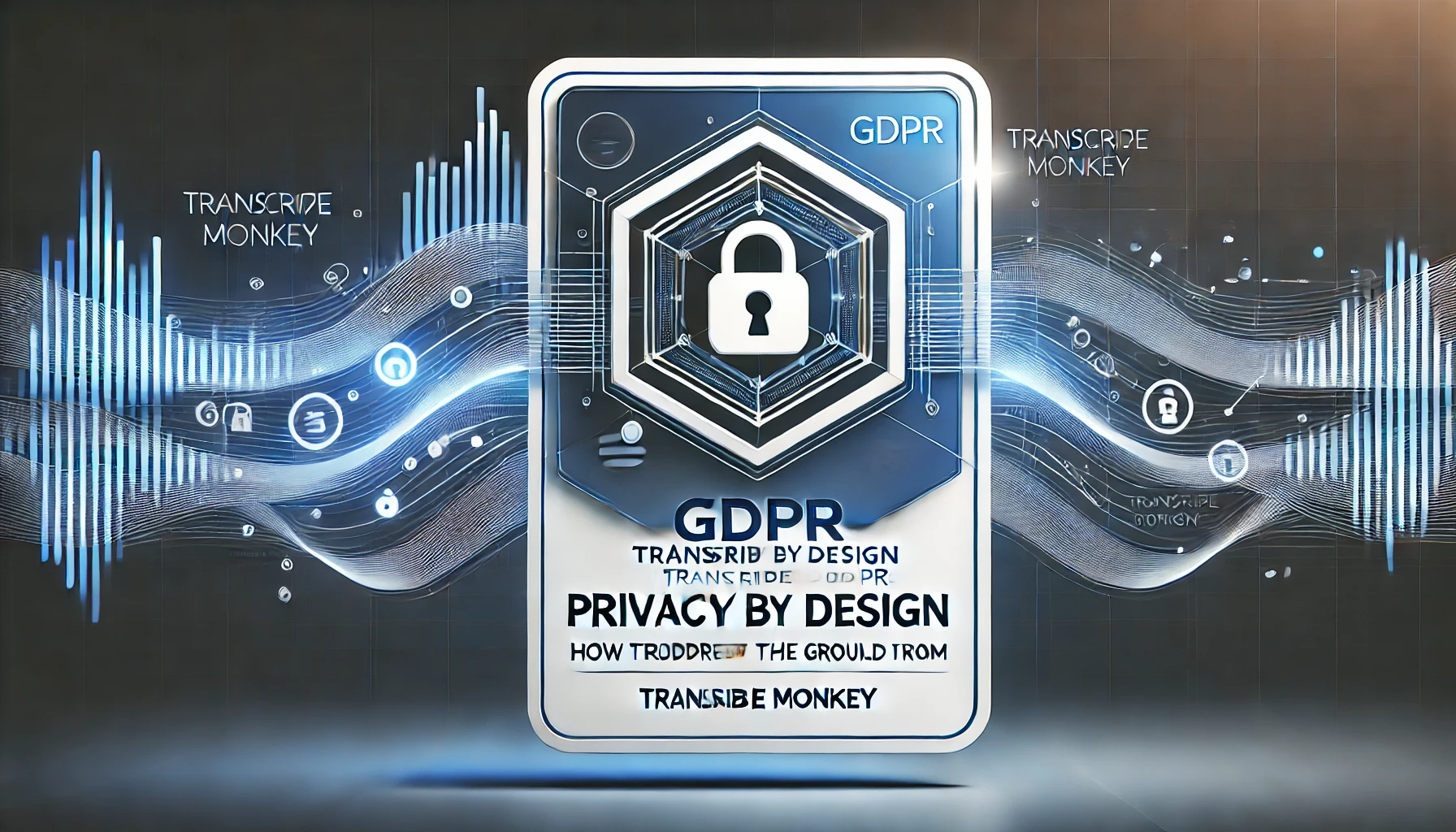From day one, Transcribe Monkey was designed with privacy as a core principle. GDPR’s requirements for data minimization, purpose limitation, and accountability were not afterthoughts—they were baked into our architecture. This post will dive deep into how we approached Privacy by Design, detailing the steps we took to ensure that every feature respects user data. We’ll discuss the importance of data flow mapping, how we minimize data collection to only what’s necessary, and the controls we’ve put in place to ensure data isn’t used beyond its intended purpose. Our team believes that privacy should be a feature, not a burden, and we’ll share how this mindset influenced every development decision.
Understanding Privacy by Design
Privacy by Design (PbD) is not just a regulatory requirement under GDPR; it’s a philosophy that influences every aspect of our software development process. At Transcribe Monkey, we believe that privacy is a fundamental right, and our mission is to protect it while delivering top-tier transcription services. PbD involves integrating privacy into the design and architecture of IT systems and business practices from the outset, rather than as an afterthought. This proactive approach ensures that privacy considerations are part of the development lifecycle from day one.
Data Flow Mapping: The Foundation of Privacy
The first step in embedding Privacy by Design into Transcribe Monkey was to understand exactly how data flows through our system. We conducted comprehensive data flow mapping to identify every touchpoint where personal data is collected, processed, stored, or transmitted. This mapping process involved several key steps:
- Identifying Data Sources: We pinpointed all the sources from which personal data enters our system, including user uploads, API integrations, and third-party services.
- Documenting Data Processing Activities: For each data source, we detailed how the data is processed—whether it’s transcribed, analyzed, stored, or shared.
- Mapping Data Storage Locations: We identified where data is stored, whether on local servers, cloud storage, or third-party platforms, ensuring that each location meets GDPR’s security standards.
- Tracking Data Transmission: We tracked how data moves between systems, both internally and externally, and ensured that all transmissions are encrypted and secure.
This meticulous mapping process allowed us to visualize the entire data lifecycle, identify potential risks, and implement safeguards at every stage.
Minimizing Data Collection: Less is More
One of the core principles of GDPR is data minimization—collecting only the data that is strictly necessary for the intended purpose. At Transcribe Monkey, we’ve embraced this principle wholeheartedly. Here’s how we ensure data minimization:
- Purpose-Driven Data Collection: Before collecting any data, we clearly define its purpose and ensure that it’s essential for providing our transcription services. For instance, we collect audio files and user contact information to deliver transcriptions and communicate with users, but we avoid collecting unnecessary details like demographic information unless explicitly required.
- Anonymization and Pseudonymization: Wherever possible, we anonymize or pseudonymize data to protect user identities. For example, audio files are assigned unique identifiers instead of using personal names, reducing the risk of identifying individuals.
- Regular Data Audits: We conduct regular audits to review the data we collect and ensure that it aligns with our data minimization policies. Any data that is no longer needed is securely deleted.
By collecting only what is necessary, we reduce the risk of data breaches and enhance user trust.
Purpose Limitation: Staying True to Our Mission
Purpose limitation is another key GDPR principle that we’ve embedded into Transcribe Monkey’s architecture. This means that we only use personal data for the specific purposes for which it was collected, and not for any other unrelated activities. Here’s how we achieve this:
- Clear Privacy Policies: Our privacy policies clearly outline the purposes for which we collect and process data. Users are informed upfront about how their data will be used, and we obtain explicit consent for any additional uses.
- Strict Access Controls: We implement role-based access controls to ensure that only authorized personnel can access specific data. For example, our transcription team can access audio files but not user contact information, while our customer support team can access contact details but not the transcriptions themselves.
- Monitoring and Enforcement: We use automated tools to monitor data usage and detect any deviations from the defined purposes. Any violations are promptly addressed, and corrective actions are taken to prevent recurrence.
By adhering to purpose limitation, we respect our users’ privacy and maintain their trust.
Accountability: Taking Responsibility for Data Protection
Accountability is at the heart of GDPR, and we take our responsibility for data protection seriously. At Transcribe Monkey, accountability means not only complying with legal requirements but also demonstrating our commitment to privacy through transparent practices and continuous improvement. Here’s how we uphold accountability:
- Appointing a Data Protection Officer (DPO): We have a dedicated DPO who oversees our data protection strategy, ensures compliance with GDPR, and serves as a point of contact for data protection inquiries.
- Documenting Compliance Measures: We maintain detailed records of our data protection measures, including data flow maps, risk assessments, and security protocols. This documentation helps us demonstrate compliance during audits and regulatory reviews.
- Regular Training and Awareness: Our team undergoes regular training on GDPR requirements and data protection best practices. By fostering a culture of privacy awareness, we ensure that everyone at Transcribe Monkey understands their role in safeguarding user data.
- Continuous Improvement: We regularly review and update our data protection practices to address emerging threats and regulatory changes. This proactive approach ensures that we stay ahead of potential risks and continuously improve our privacy framework.
Embedding Privacy into Development Decisions
Privacy by Design isn’t just about policies and procedures—it’s about making privacy a core consideration in every development decision. At Transcribe Monkey, this mindset influences everything we do:
- Designing Privacy-Friendly Features: We prioritize user privacy when designing new features. For example, our transcription editor allows users to work with anonymized data, and our export options include secure formats that protect sensitive information.
- Implementing Secure Coding Practices: Our developers follow secure coding practices to minimize vulnerabilities and protect user data. This includes input validation, secure authentication, and regular code reviews.
- User-Centric Privacy Controls: We provide users with intuitive tools to manage their privacy settings, such as opting out of data sharing, controlling who can access their transcriptions, and requesting data deletion.
By embedding privacy into our development process, we create a product that not only meets regulatory requirements but also earns the trust and loyalty of our users.
Conclusion
At Transcribe Monkey, Privacy by Design is more than a regulatory obligation—it’s a core value that shapes every aspect of our platform. By integrating GDPR principles into our architecture from the ground up, we ensure that our users’ data is protected, their rights are respected, and their trust is earned. We believe that privacy should be a feature, not a burden, and we’re proud to lead the way in building a transcription service that puts privacy first.

